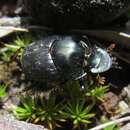en
names in breadcrumbs


Native dung beetles are not in danger of extinction.
It is unclear what the exact function of food balls is in the life cycle of the Native dung beetle. While most beetles store dung in food chambers before reproduction, the native dung beetle forms food balls during reproduction. This leads to O. australis being the only beetle found in dung when the first population of bush flies begin oviposition in the spring.
The range of the Native dung beetle is over most of southeastern Australia. It can be found from southern Queensland to Tasmania and South Australia.
Biogeographic Regions: australian (Native )
Onthophagus australis is most often found in manure in open pastures.
Terrestrial Biomes: savanna or grassland
The most distinctive feature is the segmented antennae. This antennae forms a club containing three to seven leaves. These leaves can be expanded or folded together to form one compact club. The beetle is brightly colored. The surface of the dung beetle's head varies, but it is short, broad, and partially deflexed. The eyes are oval and prominent. The wings are large and well-developed.
Other Physical Features: ectothermic ; bilateral symmetry
Native dung beetles emerge mainly during late summer into fall. For the first several weeks they are in a "maturation feeding stage". A majority of beetles are in the adult stage during the winter. Ocassionally eggs are laid in the fall, which then emerge in spring.